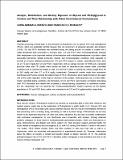Por favor, use este identificador para citar o enlazar a este item:
http://hdl.handle.net/10261/54917COMPARTIR / EXPORTAR:
 SHARE SHARE
 CORE
BASE CORE
BASE
|
|
| Visualizar otros formatos: MARC | Dublin Core | RDF | ORE | MODS | METS | DIDL | DATACITE | |

| Título: | Analysis, distribution, and dietary exposure of glyoxal and methylglyoxal in cookies and their relationship with other heat-induced contaminants |
Autor: | Arribas Lorenzo, Gema CSIC; Morales, F. J. CSIC ORCID | Palabras clave: | Glyoxal Methylglyoxal Cookies Acrylamide Hydroxymethylfurfural |
Fecha de publicación: | 2010 | Editor: | American Chemical Society | Citación: | Journal of Agricultural and Food Chemistry 58 :2966-2972 (2010) | Resumen: | Thermal processing of food leads to the formation of dicarbonyls such as glyoxal (GO) and methylglyoxal (MGO), which are potentially harmful because they are precursors of advanced glycation end products (AGEs). GO and MGO formation was examined during the baking process of cookies as cookies are a widely distributed food commodity in Western diets. GO and MGO were chromatographically analyzed after employment of an improved method of derivatization with orthophenylenediamine to produce stable quinoxaline derivatives. Sample extraction, cleanup, and chromatographic conditions were evaluated to provide an in-house validated procedure for GO and MGO analysis in cookies. Quantification limits were set at 1.5 and 2 mg/kg for GO and MGO, respectively, with an average recovery of 103% and a calculated precision lower than 7%. Studies were carried out both on laboratory-scale cookies under controlled conditions and on commercial samples as well. GO and MGO values in commercial cookies ranged from 4.8 to 26.0 mg/kg and from 3.7 to 81.4 mg/kg, respectively. Commercial cookies made from ammonium bicarbonate and fructose showed the highest levels of MGO. Dicarbonyls were rapidly formed on the upper side of the cookie regardless of the shape or thickness of the samples, confirming there was a surface effect. Under controlled baking conditions, the formations of GO and MGO were linearly correlated with baking time. MGO formation was related with acrylamide, a heat-processing contaminant, in commercial cookies, but this relationship was not observed for 5-hydroxymethylfurfural. Dietary exposure of the Spanish population to GO and MGO from cookies was estimated to be 213 and 216 μg/person/day, respectively. | Descripción: | 7 páginas,4 figuras,5 tablas. | URI: | http://hdl.handle.net/10261/54917 | DOI: | 10.1021/jf902815p | ISSN: | 0021-8561 |
| Aparece en las colecciones: | (ICTAN) Artículos |
Ficheros en este ítem:
| Fichero | Descripción | Tamaño | Formato | |
|---|---|---|---|---|
| OPEN_SCI_085.pdf | 623,24 kB | Adobe PDF |  Visualizar/Abrir |
CORE Recommender
SCOPUSTM
Citations
130
checked on 20-abr-2024
WEB OF SCIENCETM
Citations
119
checked on 24-feb-2024
Page view(s)
404
checked on 23-abr-2024
Download(s)
767
checked on 23-abr-2024
Google ScholarTM
Check
Altmetric
Altmetric
NOTA: Los ítems de Digital.CSIC están protegidos por copyright, con todos los derechos reservados, a menos que se indique lo contrario.
